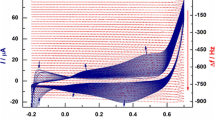A mathematical model of electrocatalytic processes taking place at conducting polymer modified electrodes has been developed. The model takes into account the diffusion of solution species into a polymer film, diffusion of charge carriers within the film, and a chemical redox reaction within the film. The space- and time-resolved profiles for reactant and charge carrier concentration within the film, as well as dependencies of electric current on the concentration of solute species, reaction rate constant and thickness of a polymer layer have been obtained and discussed. It has been shown that, even at a relatively fast diffusion of charge carriers within the conducting polymer film, exceeding the diffusion rate of reactant by two orders of magnitude, electrocatalysis of solute species at conducting polymer modified electrodes proceeds within the polymer film rather than at the outer polymer/solution interface, i.e., electrocatalytic conversion follows a redox-mechanism rather than metal-like one. Based on the results obtained, optimization of reaction system parameters could be made for any particular case to get an optimum efficiency or reactant to product conversion.
Similar content being viewed by others
References
Shirakawa H, (2002) . Synth. Metals 125: 3
MacDiarmid A.G, (2002) . Synth. Metals 125: 11
Heeger A.J, (2002) . Synth. Metals 125: 23
Malinauskas A., (1999) . Synth. Metals 107: 75
Cooper J.C, Hall E.A.H., (1993) . Electroanalysis 5: 385
Mandic Z, Duic Lj, (1996) . J. Electroanal. Chem. 403: 133
Bartlett P.N, Birkin P.R, Wallace E.N.K., (1997) . J. Chem. Soc. Faraday Trans. 93: 1951
Malinauskas A, Holze R, (1998) . Electrochim. Acta 43: 2563
Malinauskas A, Holze R., (1999) . J. Electroanal. Chem. 461: 184
Malinauskas A, R.Holze, (1999) . J. Solid State Electrochem. 3: 429
Mažeikienu R., Niaura G., Malinauskas A, (2005) . Electrochem. Commun. 7: 1021
Samarskii A.A, The Theory of Difference Schemes (Marcel Dekker, New York, 2001).
Yano J, Kokura M, Ogura K, (1994) . J. Appl. Electrochem. 24: 1164
Author information
Authors and Affiliations
Corresponding author
Rights and permissions
About this article
Cite this article
Naujikas, R., Malinauskas, A. & Ivanauskas, F. Modeling of electrocatalytic processes at conducting polymer modified electrodes. J Math Chem 42, 1069–1084 (2007). https://doi.org/10.1007/s10910-006-9172-z
Published:
Issue Date:
DOI: https://doi.org/10.1007/s10910-006-9172-z




